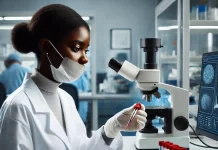SEPTEMBER 2024
In recent years, the approach to determining school readiness has undergone significant changes. Traditionally, school readiness assessments in Grade 0 focused heavily on evaluating whether children met specific academic and developmental benchmarks. However, this method often overlooked the individual growth and unique strengths of each child. Today, there is a shift towards a more holistic and supportive approach, emphasising continuous growth and tailored support, an education expert says.

“The modern approach places less emphasis on traditional assessments and more on measuring and supporting student growth over time,” says Lynda Eagle, Schools Academic Advisor at ADvTECH, Africa’s leading private education provider.
“This shift recognises that each child develops at their own pace and has unique strengths and areas for improvement. By focusing on growth, educators can better support students as they progress, extending their strengths and providing scaffolding where needed.”
THE MEANING OF SCHOOL READINESS
School readiness is an assessment of the degree to which a child is prepared to enter school and succeed in a learning environment, explains Eagle.
When considering school readiness there is a range of developmental areas – all inter-linked – that need to be considered: academic/cognitive, social, emotional and physical. Collectively, a healthy development across these areas will indicate that a child is ready and able to adapt and thrive in their new setting, she says.
“School readiness is not just about knowledge. It involves a child’s ability to adapt, to manage their emotions, to positively interact with others and to follow routines.”
AREAS OF DEVELOPMENT
Children’s development will differ according to the child’s age and stage of development. The various elements considered are broadly defined as follows:
Physical: This includes both fine and gross motors skills that facilitate the child’s ability to control their body movements with increased accuracy and precision. The development of these skills ultimately prepares children for handwriting (letter and number formation) and the more physical activities required when participating in sport – such as running, jumping, and throwing a ball.
Cognitive development: Is the ability of the child to process and demonstrate their understandings of foundational skills through problem-solving, the following of instructions, the sequencing of events, and the ability to reason and apply what they have learned to new situations.
Social development: This considers the child’s ability to interact with others, to share, take turns, engage in collaboration and cooperate with others. Do they understand social cues, and are they able to interpret and respond appropriately to social cues, and recognise emotions?
Emotional development: This involves the ability of the child to self-regulate and manage their emotions and behaviours. It facilitates the building of the child’s self-confidence and ability to work independently – to make sound choices and to operate in a community effectively.
BEYOND TRADITIONAL ASSESSMENTS – DETERMINING WHAT IS BEST FOR THE CHILD
“When we fail to consider the age and developmental stage of a child, we risk trying to grow or develop their skills before they are ready, or before they have had the necessary foundational experiences, which can have a lifetime impact if there is a rush towards achieving school readiness,” says Eagle.
“An overemphasis on academic skills can lead to moving to abstract concepts without providing enough concrete experiences. Measuring and judging students against uniform pre-determined norms or standards fail to recognise their unique needs, talents and dispositions. This approach places undue pressure on both the adults and students in an attempt to meet these milestones and often at the expense of developing important essential or soft skills”.
Additionally, failing to consider cultural contexts means that norms are based on standards that do not align with the child’s unique experiences.
“Fostering a competitive environment can place pressure on a child’s well-being, sense of belonging and identity. When a child is labelled as not ready, it implies they are not worthy, leading to judgment rather than nurturing.”
Eagle says parents and educators need to take a balanced approach by determining whether the school is ready for the child, and whether it can work with a framework that recognises the rights of the child – adapting and designing learning experiences that address gaps and challenges.
“Rather than ticking boxes to determine school readiness (or not), it is our duty to focus on the child’s emotional, social and mental health – where they feel safe then they will be open to learning. We must be flexible and adaptive – to be inclusive and affirmative in our actions and behaviours – this includes the language that we use. The overriding recognition should be that children don’t mature or learn in the same ways. That is okay, and simply requires us to adjust accordingly.”





























